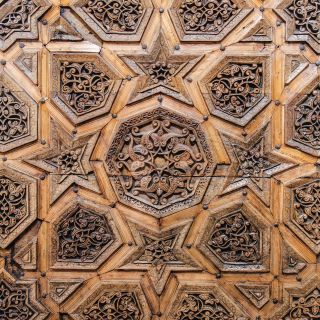ALAEDDIN MOSQUE
Turkiye ANKARA 12th Century
MUHIUDDIN MESUDOlarak da bilinir.
1197/98
It is located at the beginning of İçhisar Street in the İçkale (Inner Castle) of Ankara.
It stands on a rectangular area adjoining the fortification wall on the qibla wall.
The mihrab of the first mosque is in the fortification wall in the open area to the east of the current mosque. Currently preserved in very poor condition, this former mihrab has brick construction topped with a hood with muqarnas rising on colonnettes with dice-like capitals; there is also a mihrabiyya in the niche.
Latecomers area on the north is a portico with spoliated marble columns supporting a timber lean-to roof, and it is at a higher level than the street due to sloping terrain. The minaret with a single balcony at the northwest corner has a cylindrical brick body rising on a square socle of stone; it was added in the last repairs.
The prayer hall is covered with a timber ceiling under a pitched roof. The women’s gallery in the north was added later.
The semi-circular mihrab niche in the qibla wall was added in the repairs of the twentieth century.
The monument has undergone numerous repairs after its construction and the only thing original is actually the minbar (Friday sermon pulpit) of walnut wood. It is known that this minbar of faux-kündekari technique was made by the Carpenter Ibrahim bin Abubekr al-Rumi. The three-line inscription in naskhi script on the minbar’s door wing mentions the Sultan Muhi al-Din Masud, son of Qilich Arslan, with his title as the “king of the country of the Romans and Greeks” giving the month of Safar in AH 594. Corresponding to December/January 1197/98 of the common era this date should be accepted as the construction date of the first Seljuk monument in the Inner Castle of Ankara. The location suggests that it functioned as the palace masjid when it was built in the thirteenth century.
Two inscription plaques placed in two blind pointed-arched niches over the doorway to the prayer hall reveal that the monument was repaired by Lulu Pasha in the reign of the Ottoman Sultan Orhan in 1361/62 and then once again in 1433/34 by Sharifa Sümbül Hatun in the reign of the Ottoman Sultan Murad II. The window shutter wing currently on display at the Ankara Ethnographical Museum is thought to date to the repairs in the fifteenth century.
The condition of the inscriptions suggest that the first masjid was built in the east wing of the current mosque incorporating the mihrab in the fortification wall; that it deteriorated in the thirteenth century becoming small for the community; that it was thus expanded westward in the mid-fourteenth century, and that the old masjid was also modified in the fifteenth century.


